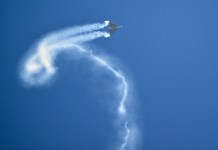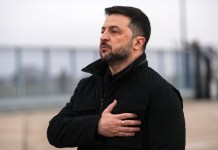With President Vladimir Putin scheduled to land in New Delhi in early December 2025, Moscow has just made its most audacious military offer to India in decades: full licensed production of the Su-57E fifth-generation stealth fighter in India, technology transfer, and a potential two-seat variant.
“Intensive work is underway across a range of areas, including the Su-57E platform, which can be utilised to implement India’s programme for developing its own fifth-generation fighter,” Russian ambassador to India Denis Alipov said in an interview.
According to the ambassador, military-technical cooperation has traditionally been one of the pillars of the special, privileged strategic partnership between Russia and India.
“Mutual trust and a willingness to accommodate New Delhi’s requirements have secured our place as India’s leading partner in this area: the country’s armed forces are 60-70% equipped with Soviet- and Russian-designed systems, which have proven themselves effective in real combat situations,” he noted.
“Our competitive advantage is an unprecedented level of technology transfer and localization of production at local facilities, in full compliance with the ‘Make in India’ and ‘Self-Sufficient India’ state programs, as well as New Delhi’s goal of increasing export potential,” Alipov said
A senior official from the Russian state arms exporter, Rosoboronexport, said in Dubai that India could initially opt for the Su-57E made in Russia. This will be followed by shifting manufacturing to India, along with “unrestricted technology transfer.” Additionally, India could license-produce air weapons tailored for next-generation aircraft.
The transfer of technology will cover the full fifth-generation ecosystem, which includes avionics, engines, sensors, stealth materials, and other classified systems. According to the official, Russia is ready to offer training in advanced air weapons, low-signature technology, AESA radar, fifth-generation engines, optics, and artificial intelligence. This access to state-of-the-art technology will help India’s own fifth-generation fighter program, the AMCA (Advanced Medium Combat Aircraft).
The Indian Air Force (IAF) has yet to formally acknowledge its interest in purchasing the Russian aircraft. In September 2025, the IAF proposed acquiring 114 Dassault Rafales, suggesting the Su-57 may be out of the picture.

Despite this, Russia has remained optimistic, banking on the fact that the capability gap between India, which has just emerged from a war with Pakistan, and its adversaries is growing, and the AMCA is unlikely to be inducted before the mid-2030s.
The IAF chief, Air Marshal A.P. Singh, said earlier this year: “We may have to go in for off-the-shelf purchases with indigenous content until AMCA is developed—or develop AMCA at a faster pace.”
Two-Seater Su-57 Variant On Cards?
It’s important to remember that India and Russia originally intended to collaborate on the development of the Fifth Generation Fighter Aircraft (FGFA), which was intended to be a two-seat Su-57 derivative.
However, India chose to end its participation in the FGFA project due to two serious flaws: the aircraft’s uncertain operational capability and its lack of crucial fifth-generation characteristics, such as supercruise. Some say that the stealth’s inferiority was also a determining factor.
Although India walked away from the FGFA, it did not rule out acquiring the aircraft at a later stage.
“In February, it was conveyed to the Russians that they could go ahead with developing the fighter without us. But the option remains, and we could well go back at a later stage and ask to buy the fighter,” former Defence Minister Nirmala Sitharaman told the Business Standard in July 2018.
A year later, in July 2019, Air Chief Marshal B.S. Dhanoa, the then Chief of Air Staff, informed the Russian Armed Forces’ official journal that India would decide on the Su-57 after witnessing it in action and after Russia displayed the aircraft in India. Further indicating that the proposition to acquire the Russian stealth jet was not off the table.
Since then, the Su-57 has been used operationally in battlefields, including in Syria and Ukraine. The aircraft has seen limited action in Ukraine but is believed to have performed well, as per reports in Russian media.
Moreover, the concerns about the absence of supercruise capability are also being addressed. For this, the Izdeliye 30, the aircraft’s second-stage fifth-generation engine, is currently undergoing flight testing and is expected to power the aircraft soon, as noted by IAF veteran and military commentator Squadron Leader Vijainder K. Thakur (retd) in a previous EurAsian Times article.
“In short, many of the IAF’s earlier concerns regarding the Su-57’s operational capability and performance envelope—particularly supercruise—are now being addressed,” he noted.
Thakur made the case of a dual-seat variant by underlining advantages such as ease of pilot training; enhanced mission management because a second crew member would ease the operational workload by managing complex systems, data fusion, and electronic warfare operations; drone mothership capability as the second pilot can be tasked with controlling loyal wingman-type drones; and the potential for a two-seater Su-57 to act as an airborne command center for mixed aircraft groups.
These advantages are significant and justifiable. In fact, China recently unveiled its two-seater J-20S—the first and only twin-seater fifth-generation stealth aircraft in the world. It has been projected as an aircraft capable of conducting precision strikes on land and sea targets, as well as carrying out medium- to long-range air superiority missions.
“Having one more pilot means having one more mission commander. In the era of fifth-generation fighter jets, the addition of a pilot to the J-20S is like a number ten player in soccer, who could both score points on his own and command the members of the warplane formation in combat,” Chinese military expert Zhang Xuefeng had explained at the time.
That said, the prospect of a dual-seat Su-57 stealth fighter may not be enough for India to make a major purchase. In fact, several voices within India’s defence community remain unconvinced and sceptical of the Su-57.
Will India Bite The Bullet?
Indian Air Force (IAF) is now down to 29 fighter aircraft squadrons vis-à-vis the authorised 42—not enough to fight a potential two-front war.
At the same time, China now has two operational fifth-generation stealth fighters (J-20 and J-35A) and is already flying two prototypes of sixth-generation combat aircraft (J-36 and J-50). Pakistan, on the other hand, is poised to acquire about 40 J-35A stealth fighters from Beijing, if not more.
In contrast, India’s fifth-generation stealth fighter, the AMCA, would not enter service for another decade and wouldn’t likely achieve Initial Operating Capability (IOC) for much longer.
Supporters of India’s Su-57 acquisition argue that the IAF’s need for stealth fighters is based on current threat perceptions, not distant future projections. Moreover, by the time India develops its own stealth fighter, manned stealth aircraft will already be losing relevance, and the next decade will see a rapid shift towards remotely piloted and autonomy-capable systems. Thus, they argue that India needs to make a tenacious attempt to acquire the Su-57 on terms that benefit the country.
They warn that even though self-reliance must assume primacy, it should be accompanied by pragmatism and feasibility.
However, a key question that has frequently been asked by experts is whether India will be able to keep the AMCA on track if it were to accept the Su-57 proposal and start producing the aircraft in the country?
There have been persisting concerns associated with simultaneously manufacturing the Su-57 locally and advancing work on AMCA, with experts warning the latter is likely to be killed if India goes all out on Su-57. In fact, some experts have also called the proposal an eyewash, raising questions over the technology transfer.
When probed on the matter, Air Marshal Anil Chopra (retd) told EurAsian Times, “The Russians are unlikely to part with the technology fully, and once we have paid the money and signed a contract, there wouldn’t be much to do about it. The best way forward is to buy 2-3 squadrons of the Su-57E, if necessary, and to focus entirely on the AMCA. It would be great if India could arm-twist the Russians into transferring crucial fifth-generation technology. However, producing the Su-57 and expanding the scope of cooperation would not benefit India. Besides these two things, India should go ahead with the acquisition of the 114 Rafale and produce the jets locally.”
“There are currently just three stealth fighters in the market—the Russian Su-57, the American F-35, and the Chinese J-35A. Russia is aware that there wouldn’t be a better market for its jets, especially since the other two alternatives are virtually off the reckoning. This is why they are pushing the aircraft with this renewed intensity and passion,” he added.
Other experts seem to suggest that the Su-57 wouldn’t impact the AMCA, arguing that local production of the Su-57 would be managed by HAL, while the ADA (Aeronautical Development Agency)—which intends to delegate AMCA manufacturing to a private company or a Special Purpose Vehicle (SPV)—would continue development independently.
Having said that, Russian officials have laid the groundwork to push the aircraft to India during Putin’s much-awaited visit. For instance, Sergey Chemezov, the CEO of Rostec, said, “India and Russia have been partners for many years. Even when India was under sanctions, we supplied the country with weapons to ensure its security… Today, we continue the same approach as in previous years, supplying India with whatever military equipment it needs and ensuring our mutual interests in developing cooperation.”
- Contact the author at sakshi.tiwari13 (at) outlook.com
- Follow EurAsian Times on Google News




